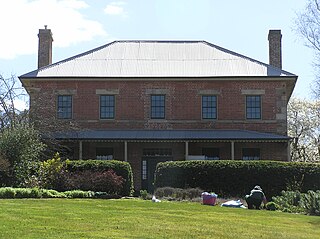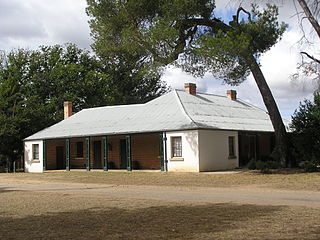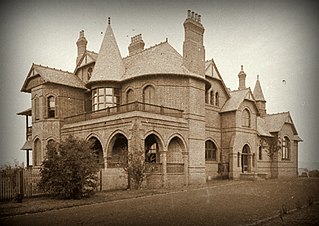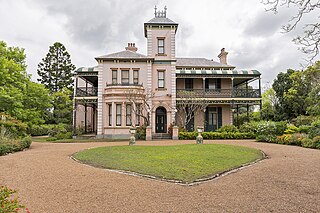
Maitland is a city in the Lower Hunter Valley of New South Wales, Australia and the seat of Maitland City Council, situated on the Hunter River approximately 166 kilometres (103 mi) by road north of Sydney and 35 km (22 mi) north-west of Newcastle. It is on the New England Highway about 17 km (11 mi) from its start at Hexham.

The Norman Lindsay Gallery and Museum is a heritage-listed former residence and farmlet and now art gallery, tourist attraction and museum located at 14-20 Norman Lindsay Crescent, in the Blue Mountains town of Faulconbridge in the City of Blue Mountains local government area of New South Wales, Australia. It was built from 1898 to 1913 by Francis Foy; Patrick Ryan; Norman Lindsay; Rose Soady. It is also known as Maryville and Springwood. The property is owned by National Trust of Australia (NSW). It was added to the New South Wales State Heritage Register on 1 March 2002. The property is a stone cottage on a 17-hectare (42-acre) block of land which was owned by the Australian artist and writer Norman Lindsay and his wife, Rose. The property also contains some smaller buildings including two used as an oil painting studio and an etching studio.

Experiment Farm Cottage is a heritage-listed former farm and residence and now house museum at 9 Ruse Street, Harris Park, City of Parramatta, Sydney, Australia. It is one of Australia's oldest standing residences, being built in 1795. It is located at the site of Experiment Farm, Australia's first European farmstead, which was itself created by Australia's first land grant. It was added to the New South Wales State Heritage Register on 2 April 1999.

Elizabeth Farm is an historic estate located at 70 Alice Street, Rosehill, a suburb of Sydney, New South Wales, Australia. Elizabeth Farm was the family home of wool pioneer, John and his wife Elizabeth Macarthur. The estate was commenced in 1793 on a slight hill overlooking the upper reaches of Parramatta River, 23 kilometres (14 mi) west of Sydney Cove. This area belonged to the Burramattagal clan of the Dharug people, whose presence is recalled in the name Parramatta.

The Government House is the heritage-listed vice-regal residence of the Governor of New South Wales, Australia, located on Conservatorium Road in the Sydney central business district adjacent to the Royal Botanic Gardens, overlooking Sydney Harbour, just south of the Sydney Opera House. Constructed between 1837 and 1843, the property has been the vice-regal residence of the Governor since Sir George Gipps, except for two brief periods; the first between 1901 and 1914, when the property was leased to the Commonwealth of Australia as the residence of the Governor-General of Australia, and the second from 1996 to 2011.

Vaucluse House is a heritage-listed former Aboriginal land, residence, colonial farm and country estate and now tourist attraction, house museum and public park located at 69a Wentworth Road, Vaucluse in the Municipality of Woollahra local government area of New South Wales, Australia. Completed between 1803 and 1839 in the Gothic Revival style, its design was attributed to William Charles Wentworth and built by Sir Henry Browne Hayes and W. C. Wentworth. The property is owned by the Historic Houses Trust of New South Wales, an agency of the Government of New South Wales. The site was added to the New South Wales State Heritage Register on 2 April 1999.

Cooma Cottage is a heritage-listed former farm and tuberculosis sanatorium and now house museum and historic site at Yass Valley Way, Marchmont, Yass Valley Shire, New South Wales, Australia. It was built from 1830 to 1837 by Cornelius and Rebecca O'Brien. It is also known as Hamilton Hume's House,Humedale Stud, and New Nordrach Institute for Consumption. The property is owned by the National Trust of Australia (NSW). It was added to the New South Wales State Heritage Register on 1 March 2002.

Harper's Mansion is a heritage-listed house and now house museum in Berrima, Wingecarribee Shire, New South Wales, Australia. It is recognised for its Georgian design. Harper's Mansion is now a property of the National Trust of Australia (NSW), which acquired it in 1978. It was added to the New South Wales State Heritage Register on 1 March 2002.

Riversdale is a heritage-listed house in the early colonial Regency style located in Goulburn, New South Wales, Australia. The house was built in about 1840 and some of the outbuildings were constructed even earlier. The house is listed on the New South Wales State Heritage Register and the property is owned by the National Trust of Australia. It was added to the New South Wales State Heritage Register on 1 March 2002.

Camelot is a heritage-listed former residence, race horse stud and homestead and now large home located at Kirkham Lane in the south-western Sydney suburb of Narellan in the Camden Council local government area of New South Wales, Australia. It was designed by John Horbury Hunt and built from 1881 to 1888. It is also known as Camelot and Kirkham. It was added to the New South Wales State Heritage Register on 2 April 1999.

Meroogal is a heritage-listed former residence and now house museum at 35 West Street, Nowra, City of Shoalhaven, New South Wales, Australia. It was designed by Kenneth Mackenzie and built in 1886 by Kenneth Mackenzie. The property is owned by the Historic Houses Trust of New South Wales. It was added to the New South Wales State Heritage Register on 2 April 1999.

Cintra House is a heritage-listed residence and one-time private hospital at 34 Regent Street, Maitland, City of Maitland, New South Wales, Australia. It was designed by John Wiltshire Pender with a garden by Sydney landscape architect R. Culbert. It was built from 1879 by Robert James with an 1887 extension by H. Noad. It is also known as Cintra. It was added to the New South Wales State Heritage Register on 31 August 2012.

Brough House is a heritage-listed former residence and premises for the Maitland Girls' High School and Maitland Art Gallery and now house museum at Church Street, Maitland, City of Maitland, New South Wales, Australia. It was built from 1860 to 1862 by Isaac Beckett and Samuel Owens. The property is owned by the National Trust of Australia (NSW). It is associated with neighbouring Grossmann House, which is also owned by the National Trust. It was added to the New South Wales State Heritage Register on 1 March 2002.

Englefield is a heritage-listed former inn and now residence at 49 Newcastle Street, East Maitland, City of Maitland, New South Wales, Australia. It was built in 1837. It operated as the Black Horse Inn from 1845 to 1878. It was added to the New South Wales State Heritage Register on 30 April 2008.

Aberglasslyn House is a heritage-listed residence and former boarding school at Aberglasslyn Road, Aberglasslyn, City of Maitland, New South Wales, Australia. It was designed by John Verge and built from 1840 to 1842. It is also known as Aberglasslyn and Aberglasslyn Homestead. It was added to the New South Wales State Heritage Register on 2 April 1999.

St Mary's the Virgin Anglican Church is a heritage-listed Anglican church at 66 Church Street, Maitland, City of Maitland, New South Wales, Australia. It was designed by Edmund Blacket. It was added to the New South Wales State Heritage Register on 2 April 1999.

Woodlands is a heritage-listed residence at 44 King Street, East Maitland, City of Maitland, New South Wales, Australia. It was added to the New South Wales State Heritage Register on 2 April 1999.

The Briars is a heritage-listed residence located at 14 Woonona Avenue, in the Sydney suburb of Wahroonga in the Ku-ring-gai Council local government area of New South Wales, Australia. It was designed by Charles H. Halstead. It was added to the New South Wales State Heritage Register on 2 April 1999.

Woodford Academy is a heritage-listed former academy school, inn, private residence, boarding house and private hospital and now retail building, museum, tourist attraction, art gallery and coffeehouse at 90-92 Great Western Highway, Woodford in the City of Blue Mountains local government area of New South Wales, Australia. It was built from 1828 to 1835 by Thomas Michael Pembroke. It is also known as Woodman's Inn, King's Arms Inn, Buss's Inn, Woodford House and Woodford Academy. The property is owned by the National Trust of Australia (NSW). It was added to the New South Wales State Heritage Register on 1 March 2002.




















